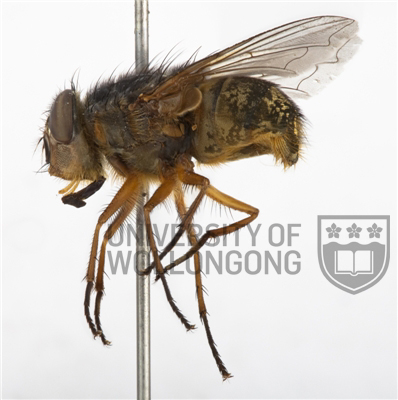Taxonomy
Family: Calliphoridae
Subfamily: Calliphorinae
Genus: Calliphora Robineau-Desvoidy 1830
Subgenus: Neocalliphora Brauer & Bergenstamm 1891
Species: stygia (Fabricius 1782)
The first-instar larva was described by O'Flynn and Moorhouse (1983), the second-instar by Erzinçlioglu (1984) and O'Flynn and Moorhouse (1983), and the third-instar larva by Erzinçlioglu (1984) and Wallman (2001).
Biology
Calliphora stygia is extremely common throughout eastern Australia. It is replaced in Western Australia by its sister species, Calliphora albifrontalis. The species is oviparous but reported as being viviparous during summer in New Zealand (Dear 1985). This has not been observed in Australia. It acts as a primary myiasis agent on sheep in Australia and New Zealand, especially in cooler months when Chrysomya and Lucilia species are in low abundance (Norris 1959). The species is adapted to lower temperatures than other common sheep blowflies (Norris 1959). Levot et al. (1979) and O’Flynn (1983) provided some larval developmental data for C. stygia.
Calliphora stygia is morphologically similar to C. albifrontalis, with the upper third of the fore femora being totally orange, whereas this region is darkened in C. albifrontalis. Male C. stygia can be readily distinguished by the minimum frons width being less than the width of the anterior ocellus, whereas in male C. albifrontalis the minimum frons width is greater than the width of the anterior ocellus (see picture). To determine the gender of your fly click here.
Distribution
Calliphora
stygia is common in south-eastern Australia, known from the Australian Capital Territory, New South
Wales, Queensland, South Australia, Tasmania and Victoria.
It is also occurs as an introduction in New Zealand.
Relevant Literature
Dear,
J P. (1985) Calliphoridae (Insecta, Diptera). Fauna of New Zealand 8, 86.
Erzinçlioglu,
Y.Z. (1984) Studies on the
morphology and taxonomy of the immature stages of
Calliphoridae, with analysis of phylogenetic relationships
within the family, and between it and other groups in the
Cyclorrhapha (Diptera). Ph.D., University of Durham.
Levot, G.W.,
Brown, K.R. and Shipp, E. (1979) Larval growth of some
calliphorid and sarcophagid Diptera. Bulletin of
Entomological Research 69, 469-475.
Norris,
K.R. (1959) The ecology of sheep blowflies in Australia. In: Keast, A.,
Crocker, R.L. and Christian, C.S. (eds.) Biogeography and
Ecology in Australia. DW. Junk, Netherlands.
O'Flynn,
M.A. (1983) The succession and rate of development of
blowflies in southern Queensland and the application of
these data to forensic entomology. Journal of the
Australian Entomological Society 22, 137-148.
O'Flynn, M.A. and
Moorhouse, D.E. (1980) Identification of early immature
stages of some common Queensland carrion flies. Journal of the
Australian Entomological Society 19, 53-61.
Wallman, J.F. (2001) Third-instar larvae of common carrion-breeding blowflies of the genus Calliphora (Diptera: Calliphoridae) in South Australia. Invertebrate Taxonomy 15, 37-51.




